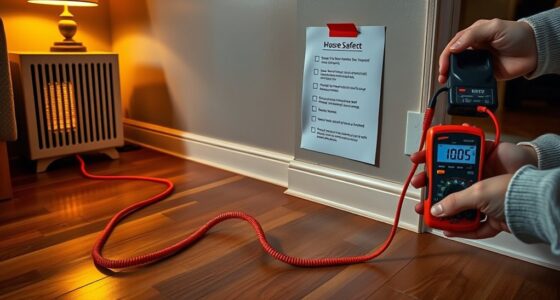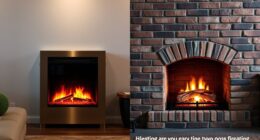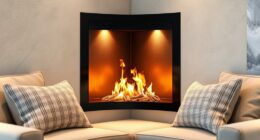Before you start, it’s important to know that smoke alarms and heat alarms serve different safety roles—smoke alarms detect airborne particles from fires, while heat alarms sense temperature changes. A common myth is they’re interchangeable, but each suits specific areas better. Proper placement, regular testing, and understanding their functions will keep your home protected. Keep exploring to discover essential facts that help you choose and maintain the right alarms for your safety.
Key Takeaways
- Understand that smoke alarms detect airborne particles, while heat alarms sense temperature changes, serving different fire detection needs.
- Proper placement is crucial: smoke alarms on ceilings away from drafts, heat alarms in garages or kitchens.
- Regular testing and battery replacement ensure both alarm types function effectively and reliably.
- Relying solely on one alarm type can compromise safety; use both for comprehensive fire protection.
- Debunk myths by recognizing that smoke and heat alarms use different technologies and are not interchangeable.
Common Myths About Smoke and Heat Alarms Debunked

Many people believe that smoke alarms and heat alarms serve the same purpose, but this is a common myth. Both play vital roles in fire safety, yet they use different alarm technology to detect hazards. Smoke alarms sense airborne particles from smoke, providing early warning for fires that produce smoke early on. Heat alarms, on the other hand, detect rapid increases in temperature or fixed high temperatures, making them ideal for kitchens or garages where smoke alarms might trigger false alarms. Understanding these differences helps you choose the right alarm for each area. Relying solely on one type can compromise your fire safety. Proper knowledge about alarm technology ensures you’re effectively protected against different fire risks, ultimately saving lives and property. Additionally, knowing how to maintain and test alarms properly is crucial for ensuring ongoing reliability and safety.
Essential Facts to Know Before Installing or Upgrading Your Alarms

Before installing or upgrading your fire alarms, it’s crucial to understand the differences between smoke and heat alarms and how each functions. Proper placement guidelines ensure maximum effectiveness and safety. Smoke alarms should be installed on ceilings or high on walls, away from drafts, bathrooms, or kitchens to reduce false alarms. Heat alarms are best placed in garages or laundry rooms, where smoke detectors might trigger unnecessarily. Regular alarm maintenance, including testing monthly and replacing batteries annually, keeps your system reliable. Remember, alarms should be installed at least 10 feet from cooking appliances to minimize false warnings. Here’s a quick reference:
| Alarm Type | Placement Guidelines | Maintenance Tips |
|---|---|---|
| Smoke Alarm | Ceilings, high on walls | Test monthly, replace batteries yearly |
| Heat Alarm | Garages, kitchens | Check sensors regularly |
Frequently Asked Questions
Can Smoke Alarms Detect Carbon Monoxide?
No, smoke alarms can’t identify carbon monoxide. To safeguard yourself from this dangerous gas, you need a dedicated carbon monoxide alarm. Place it near sleeping areas and on each level of your home for effective detection. Regularly test and replace batteries to guarantee it works properly. Remember, combining smoke alarms with carbon monoxide detectors maximizes your safety and helps alert you promptly to both fire and gas hazards.
Are Heat Alarms Suitable for All Home Areas?
Heat alarms are suitable for most home areas, especially kitchens and garages, where smoke alarms can cause false alerts. When planning your home installation, consider alarm placement carefully—place heat alarms in high-heat zones and avoid damp or dusty areas. This coincidence of proper placement and alarm type guarantees reliable detection. By matching heat alarms to the right spaces, you protect your home effectively without unnecessary false alarms.
How Often Should Alarms Be Tested and Replaced?
You should test your alarms monthly to verify they’re working properly, especially considering battery life. Replace batteries at least once a year or when the alarm chirps, indicating low power. Replace the entire unit every 8-10 years, depending on the manufacturer’s guidelines. Regular testing keeps you aware of their functionality, and timely replacements prevent failures during emergencies, giving you peace of mind and maximum protection.
Do Smoke and Heat Alarms Work Together Effectively?
Imagine a kitchen fire triggers a heat alarm, but your smoke alarm remains silent. When properly installed with correct sensor placement and alarm interconnectivity, smoke and heat alarms work together effectively, providing thorough fire detection. They complement each other by covering different scenarios, guaranteeing you get early warnings from both smoke and heat sources. This coordination maximizes safety, so ensure your alarms are interconnected and correctly positioned for peak performance.
Are There Specific Alarms for Commercial Versus Residential Use?
Yes, there are specific alarms for commercial versus residential use. Commercial regulations often require more advanced systems with features like integration with fire suppression and emergency protocols, while residential standards focus on basic smoke and heat detection for safety. You should choose alarms that meet local codes and standards, ensuring proper coverage and functionality. Always verify that the alarms you install comply with the appropriate regulations for your property type.
Conclusion
Now that you know the truth about smoke and heat alarms, don’t let myths put your safety at risk. Ignoring proper alarms could mean the difference between life and death—literally! Arm yourself with facts, install the right alarms, and stay vigilant. Don’t wait until it’s too late; your loved ones’ lives depend on your action. Take control today, because nothing is more precious than your safety—everything else is just a false alarm.









